A visit to Hauser & Wirth Downtown LA: architecture, gardens, food & art
recessed.space got a tour of Hauser & Wirth’s gallery complex
in Downtown Los Angeles, a centre not only profiling great art, but also offering
gardens, food, cultural shopping & community education. With photographs
from Carlo Zambon, we have a look at the heritage & design of the whole-block
site.
International gallery behemoth, Hauser & Wirth, currently
present works across 19 locations and three continents. In some industries,
when such a brand goes global, individual identity and sense of place can be
lost in favour of a homogenisation and often-bland aesthetic. However, Hauser
& Wirth – founded in 1992 by Iwan Wirth, Manuela Wirth, and Ursula Hauser –
take pleasure in honing the unique architecture and characteristics of each
place, creating a network of not only exhibition spaces but richer cultural
destinations in the process.
These include Hauser & Wirth Somerset, a We visited late last year for the major Phyllida Barlow exhibition guest-curated by Francis Morris – an exhibition that filled the various architectural spaces across the rural campus, also spilling into the Piet Oudolf-designed gardens and outbuildings (see 00239). Visitors can also drink in the Roth Bar, shop in the farm shop, and eat at their restaurant, while a barn is also the HQ of the gallery’s learning programme. There is also a destination gallery complex on a Menorcan island, utilising the 18th century outbuildings of a former naval hospital.
![]()
![]()
Each of their galleries has a different architectural language and story, so recessed.space visited one of Hauser & Wirth’s more unique offerings in Downtown Los Angeles to find not only a suite of gallery spaces, but a large and romantic post-industrial architectural reimagining comprising contemporary art as well as nature, food, and learning.
Located in the former Globe Grain & Milling complex, the gallery appointed Seldorf Architects to imagine how the site could be reconfigured. The block featured a tall mill tower, neo-classical banking building, and assorted other garages and sheds, all sold to the Pillsbury Flower Mills Company in the early 1940s.
The post-industrial shift in LA from the 1960s saw businesses move away from Downtown and a decline in commercial uses of the area, but a gradual rise in cultural and creative occupations of the area’s abandoned buildings and factories. Now called the Downtown Arts District, Hauser & Wirth has countless cultural neighbours, including the Southern California Institute of Architecture (SCI-Arc), production houses, design agencies, galleries, and assorted creative industries.
Anabelle Selldorf worked with Evan Raabe, an architect with Creative Space, on the renovations of the Globe Mills buildings. Talking to the LA Times in 2016, the year the gallery opened, Selldorf described her role in the project as being “mostly helpful in the big picture” in a process that was more about urban archaeology and recognising the qualities of the existing architecture more than interrupting it with grand gestures.
This recognition of what remained went further than the architectural shell. While renovation process was underway, a local street historian worked with the design team to identify several existing graffiti murals around the block, which were restored and then complemented by new commissions to develop the character of the place.
![]()
![]()
![]()
Architecturally, Selldorf and Raabe’s main gesture was to strip back some of the structure and open up the site. A key element in this was the creation of a “breezeway” cutting through the centre of the space, something Selldorf describes more as an urban design gesture than one of architecture. The intent here was to create a place with more than one entrance, softening the division between public city and private campus, and opening up a new possibility for Hauser & Wirth to programme and build their activities on the site.
What had been the site’s garages now became an open courtyard with nature allowed to grow up the stripped back industrial architecture to a level that holds back from ruinlust but constantly reminds of the history of the place. Studio MLA led on the landscape approach to the courtyard, creating a garden of Californian plants ascending to the roof level.
![]()
fig.vi
There are two distinct galleries at Hauser & Wirth Downtown LA, totalling around 560 square metres. One of these is a warehouse space, large open rooms sitting on the northern side of the courtyard. When we visited the gallery was not the expected white-wall sequence of rooms, but a darkness. Presented for the first time since it was debuted in New York in 2002, David Hammons presented Concerto in Black and Blue, an unlit blackness punctuated only by coin-size torches given to each visitor upon entry which can be turned on, off, moved or kept still at will.
A simple gesture, the work not only exists differently for each visitor, but changes dependent upon how many people are in the space and, indeed, how anybody inside behaves. The space can become a soundless disco of silhouettes, momentary architectural geometry, and shadows. Or, with few people in, it can become a personal somewhat-psychological labyrinth through emptiness. A lot has changed, especially recently in the US, over the last two decades, and for Hammons, a Black artist, to revive the work at a time of political upheaval and state-sanctioned racism, and ICE, the work invites questions around immateriality, blackness, and disappearance, but also provokes the visitor for deeper concentration, use of all senses for full awareness, and existing in a social space of trust and watching out for one another.
Having found the exit and returned to the open air, the visitor faces Manuela on the other side of the courtyard, a restaurant part of Hauser & Wirth’s international hospitality company Art Farm. It was designed by LA native Matt Winter, the tables outside surrounded by verdant planting, those inside decorated with artworks by leading artists from the gallery. There are other connections between the landscaping and restaurant than aesthetic – another Studio MLA garden, the City Garden, acts as a kitchen garden, providing seasonal herbs, fruits, vegetables, and even eggs from 12 rare-breed chickens.
![]()
![]()
![]()
The food that Executive Chef Kris Tominaga creates changes regularly and is very competitively priced. Our al fresco table was soon covered in colourful plates including: Louisiana shrimp roll; green salsa chilaquiles with fried egg, pepitas, and crema; blood orange, avocado, and pistachio salad; blistered snap peas, black quinoa, and sesame date butter. As well as the food, there are cocktails, mocktails, and a vast selection of wines and beers, plenty to refresh before hitting some more art…
The other gallery in the Downtown LA space is inside the former banking building, a solid neoclassical building, decorated in places with the Global Grain and Milling logo, and now toplit with a huge rooflight cutting through the main space. When we visited, paintings by British artist George Rouy were showing distorted, moving, and overlayed human figures. Titled The Bleed, Part II (Part I was presented in Hauser & Wirth’s London gallery last year) the abstracted paintings show forms seemingly between places, whether life/death, still/movement, or pleasure/pain.
![]()
![]()
Other spaces around the reimagined industrial buildings open up for other cultural uses. The Ursula Kiosk presents and profiles the in-house magazine, Ursula. ARTBOOK @ Hauser & Wirth is a packed bookshop with a wide selection of cultural titles, including the gallery’s own imprint. Downstairs, spaces are offered up for community workshops and education through partnerships with local institutions including SCI-Arc, the Hammer Museum, LA Public Library, California Institute of the Arts, and the Garden School Foundation.
![]()
Few galleries seek to do much more than show and sell art, and often art gallery architecture reflects this simple transactional existence – white boxes easily inserted into any commercial space, quick to build quick to leave should the market change. Hauser & Wirth go deeper. Sure, they want to sell art, but it’s part of a wider ecosystem that adds value to the objects shown and sold, but also adds value to their existence in a place, whether that be an island or city centre, and whether they are working with nature or people. Architecture is central to it, not only as a contextual backdrop, but to create the specific conditions and approaches to everything that grows within.
These include Hauser & Wirth Somerset, a We visited late last year for the major Phyllida Barlow exhibition guest-curated by Francis Morris – an exhibition that filled the various architectural spaces across the rural campus, also spilling into the Piet Oudolf-designed gardens and outbuildings (see 00239). Visitors can also drink in the Roth Bar, shop in the farm shop, and eat at their restaurant, while a barn is also the HQ of the gallery’s learning programme. There is also a destination gallery complex on a Menorcan island, utilising the 18th century outbuildings of a former naval hospital.
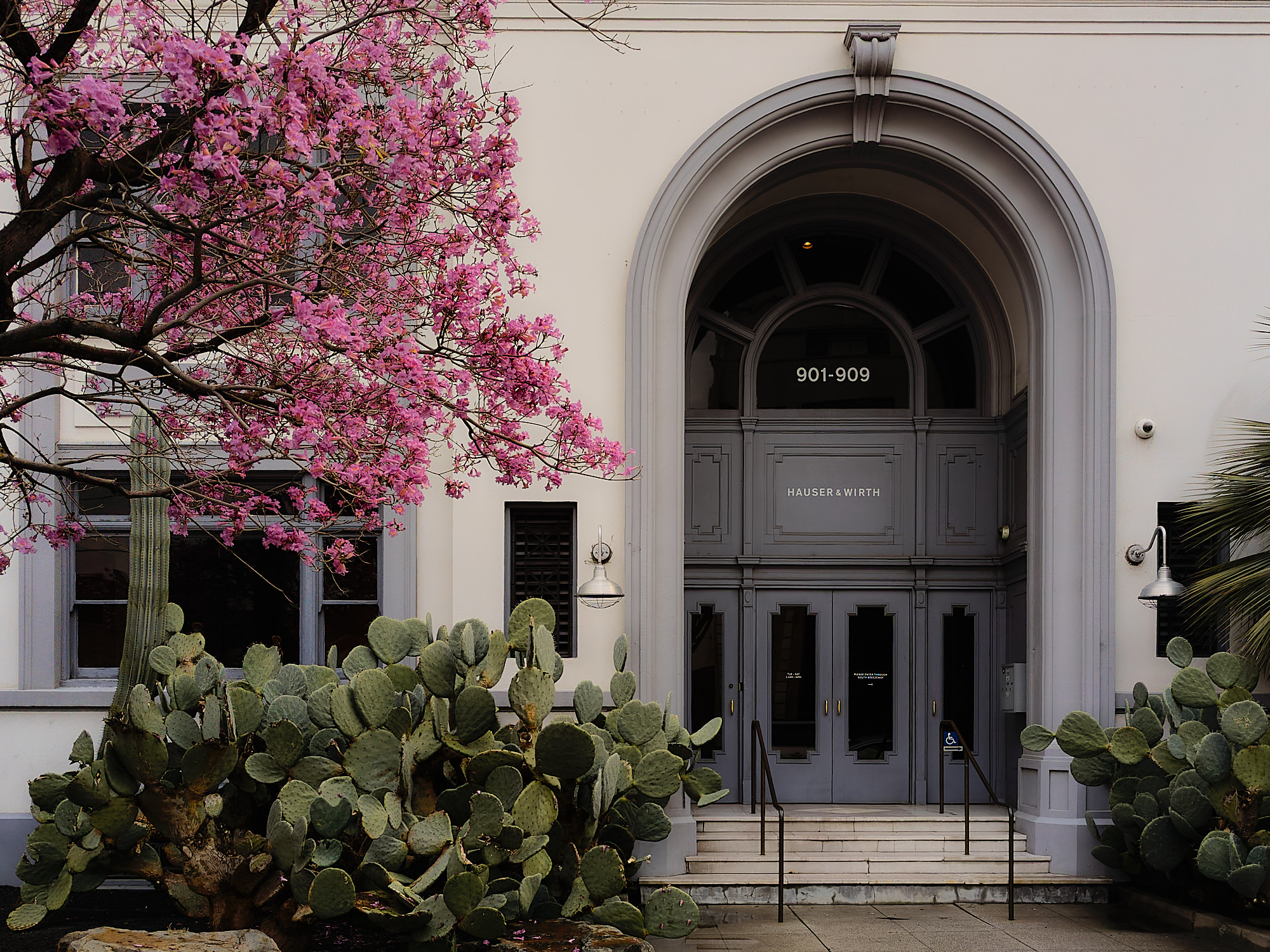
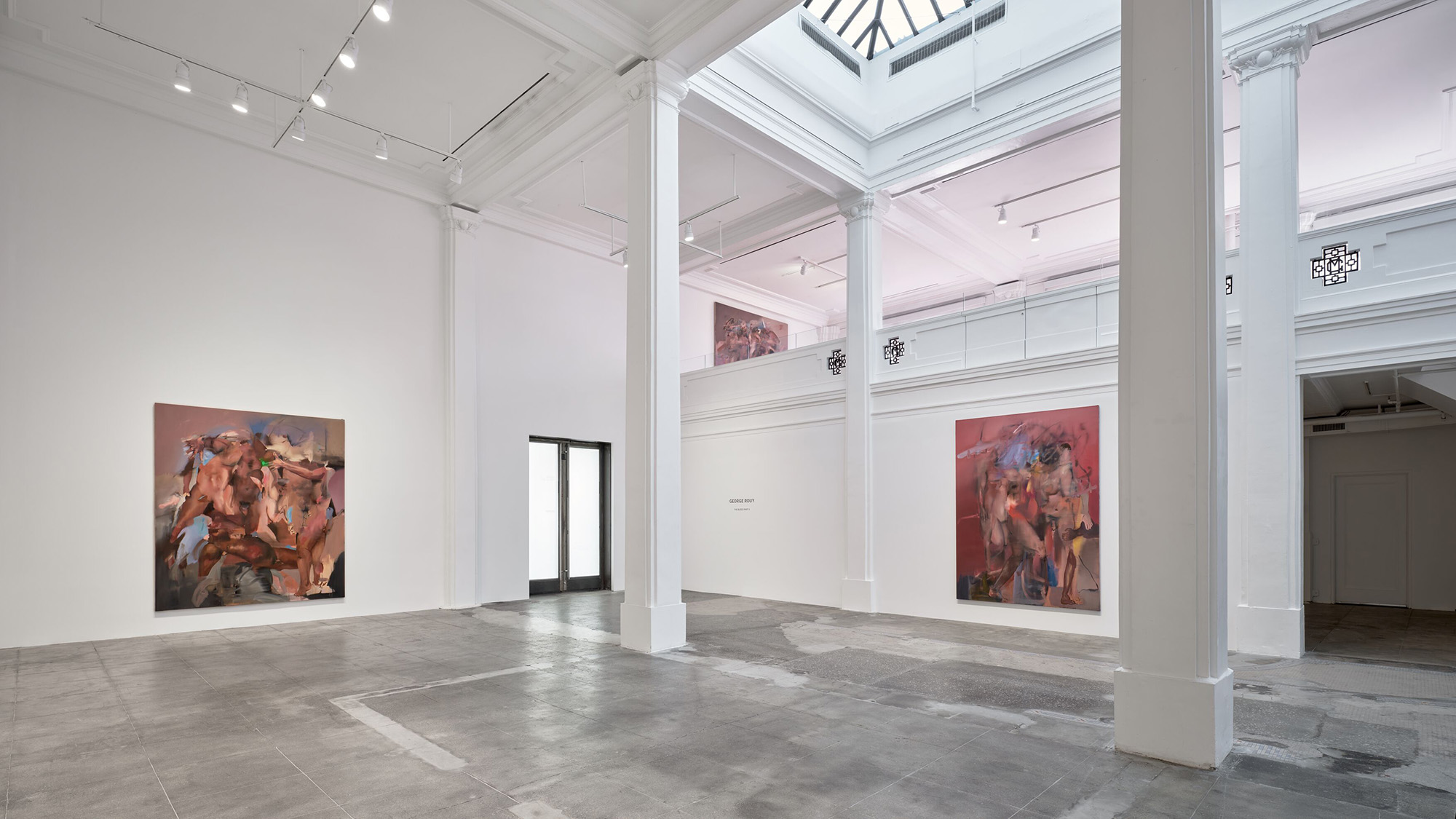
figs.i,ii
Each of their galleries has a different architectural language and story, so recessed.space visited one of Hauser & Wirth’s more unique offerings in Downtown Los Angeles to find not only a suite of gallery spaces, but a large and romantic post-industrial architectural reimagining comprising contemporary art as well as nature, food, and learning.
Located in the former Globe Grain & Milling complex, the gallery appointed Seldorf Architects to imagine how the site could be reconfigured. The block featured a tall mill tower, neo-classical banking building, and assorted other garages and sheds, all sold to the Pillsbury Flower Mills Company in the early 1940s.
The post-industrial shift in LA from the 1960s saw businesses move away from Downtown and a decline in commercial uses of the area, but a gradual rise in cultural and creative occupations of the area’s abandoned buildings and factories. Now called the Downtown Arts District, Hauser & Wirth has countless cultural neighbours, including the Southern California Institute of Architecture (SCI-Arc), production houses, design agencies, galleries, and assorted creative industries.
Anabelle Selldorf worked with Evan Raabe, an architect with Creative Space, on the renovations of the Globe Mills buildings. Talking to the LA Times in 2016, the year the gallery opened, Selldorf described her role in the project as being “mostly helpful in the big picture” in a process that was more about urban archaeology and recognising the qualities of the existing architecture more than interrupting it with grand gestures.
This recognition of what remained went further than the architectural shell. While renovation process was underway, a local street historian worked with the design team to identify several existing graffiti murals around the block, which were restored and then complemented by new commissions to develop the character of the place.
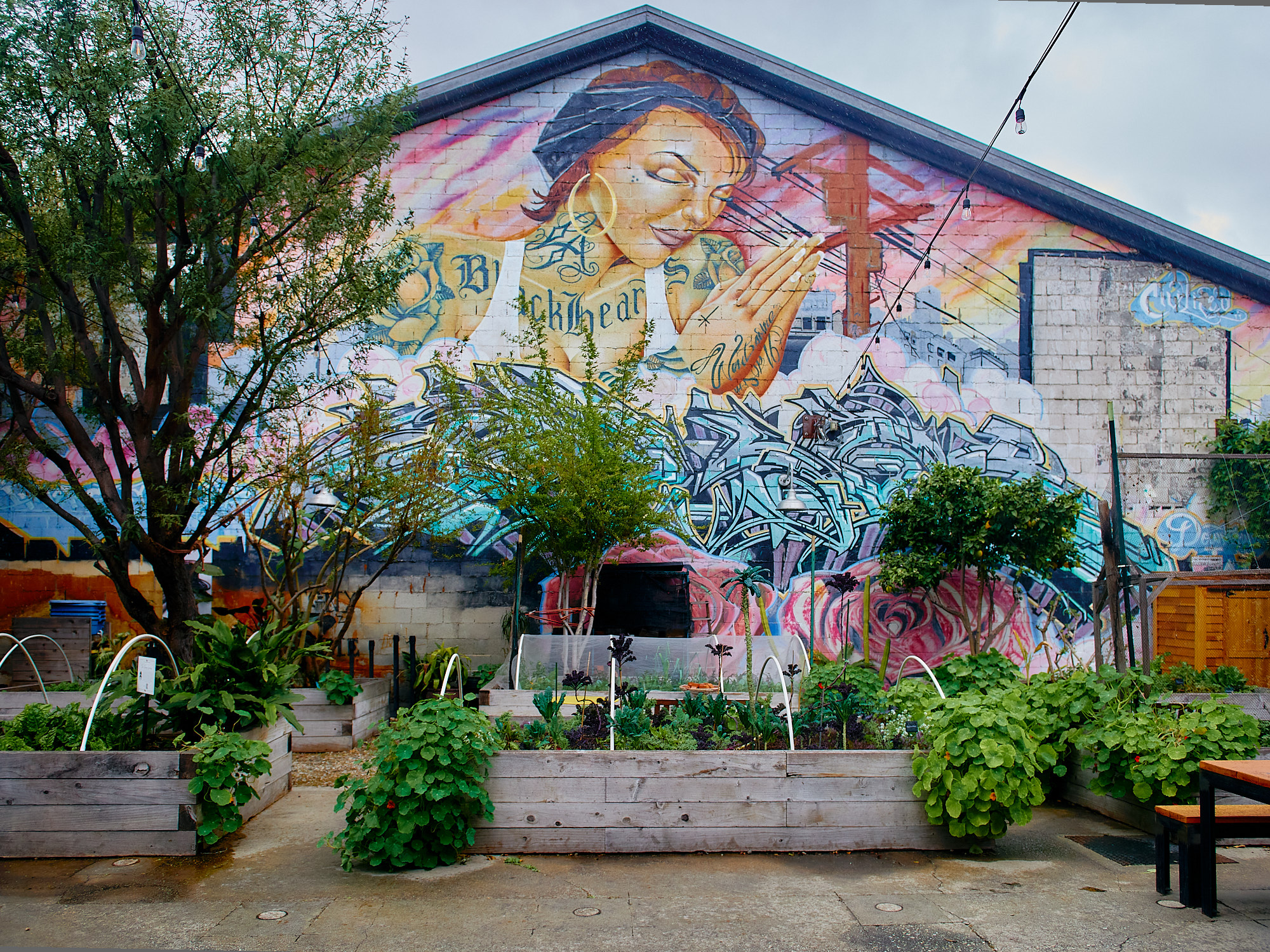
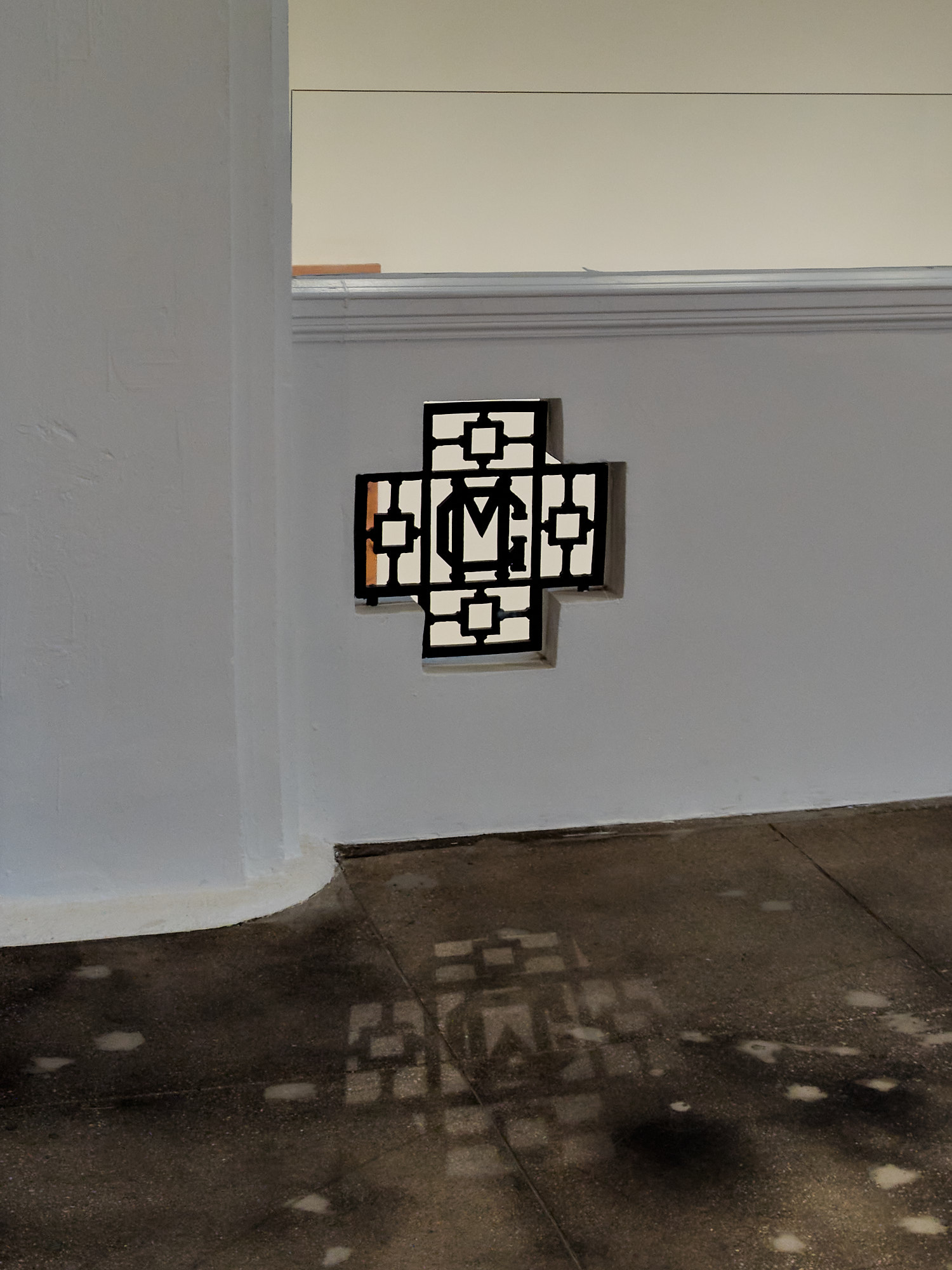

figs.iii-v
Architecturally, Selldorf and Raabe’s main gesture was to strip back some of the structure and open up the site. A key element in this was the creation of a “breezeway” cutting through the centre of the space, something Selldorf describes more as an urban design gesture than one of architecture. The intent here was to create a place with more than one entrance, softening the division between public city and private campus, and opening up a new possibility for Hauser & Wirth to programme and build their activities on the site.
What had been the site’s garages now became an open courtyard with nature allowed to grow up the stripped back industrial architecture to a level that holds back from ruinlust but constantly reminds of the history of the place. Studio MLA led on the landscape approach to the courtyard, creating a garden of Californian plants ascending to the roof level.

fig.vi
There are two distinct galleries at Hauser & Wirth Downtown LA, totalling around 560 square metres. One of these is a warehouse space, large open rooms sitting on the northern side of the courtyard. When we visited the gallery was not the expected white-wall sequence of rooms, but a darkness. Presented for the first time since it was debuted in New York in 2002, David Hammons presented Concerto in Black and Blue, an unlit blackness punctuated only by coin-size torches given to each visitor upon entry which can be turned on, off, moved or kept still at will.
A simple gesture, the work not only exists differently for each visitor, but changes dependent upon how many people are in the space and, indeed, how anybody inside behaves. The space can become a soundless disco of silhouettes, momentary architectural geometry, and shadows. Or, with few people in, it can become a personal somewhat-psychological labyrinth through emptiness. A lot has changed, especially recently in the US, over the last two decades, and for Hammons, a Black artist, to revive the work at a time of political upheaval and state-sanctioned racism, and ICE, the work invites questions around immateriality, blackness, and disappearance, but also provokes the visitor for deeper concentration, use of all senses for full awareness, and existing in a social space of trust and watching out for one another.
Having found the exit and returned to the open air, the visitor faces Manuela on the other side of the courtyard, a restaurant part of Hauser & Wirth’s international hospitality company Art Farm. It was designed by LA native Matt Winter, the tables outside surrounded by verdant planting, those inside decorated with artworks by leading artists from the gallery. There are other connections between the landscaping and restaurant than aesthetic – another Studio MLA garden, the City Garden, acts as a kitchen garden, providing seasonal herbs, fruits, vegetables, and even eggs from 12 rare-breed chickens.
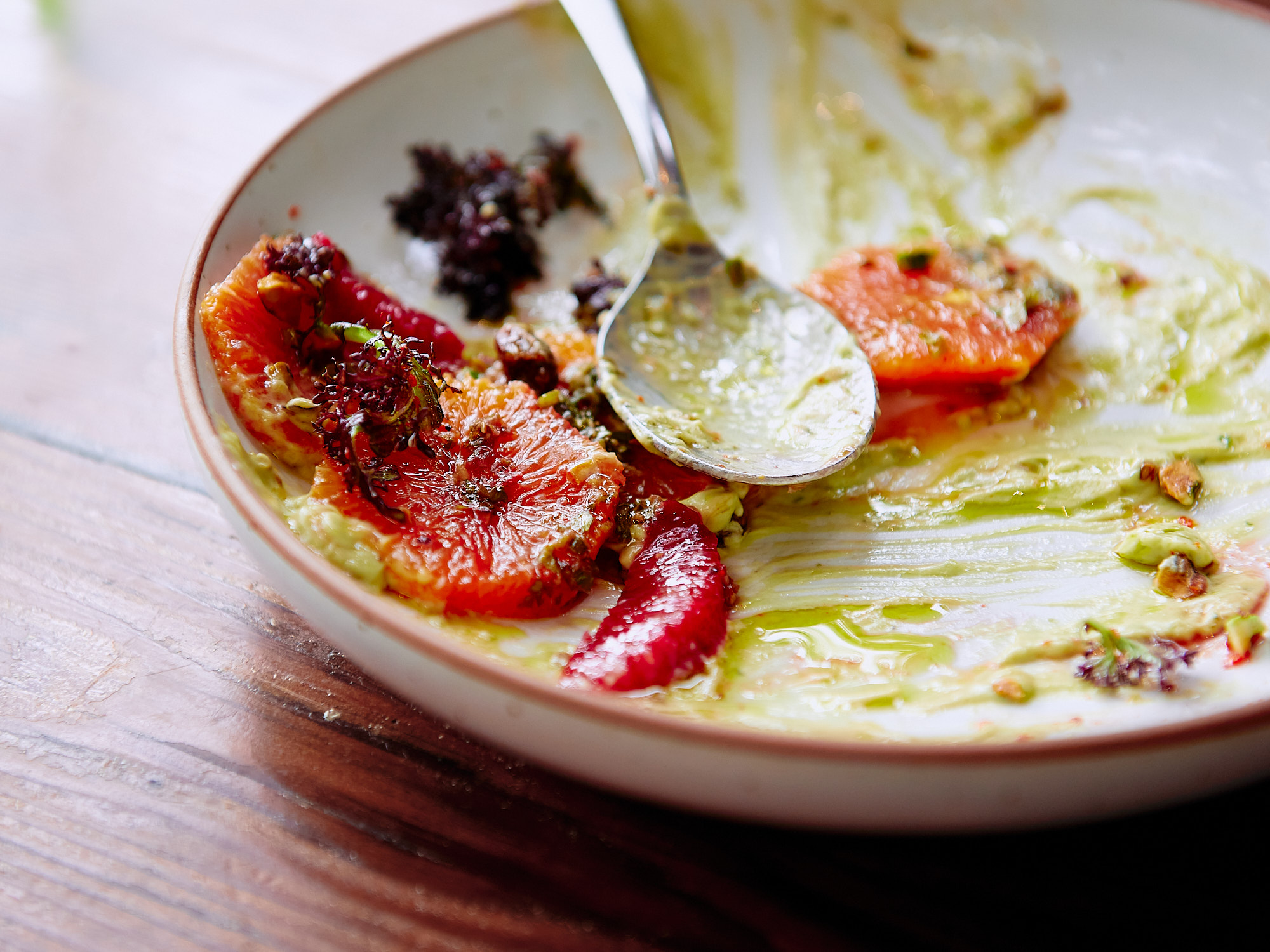
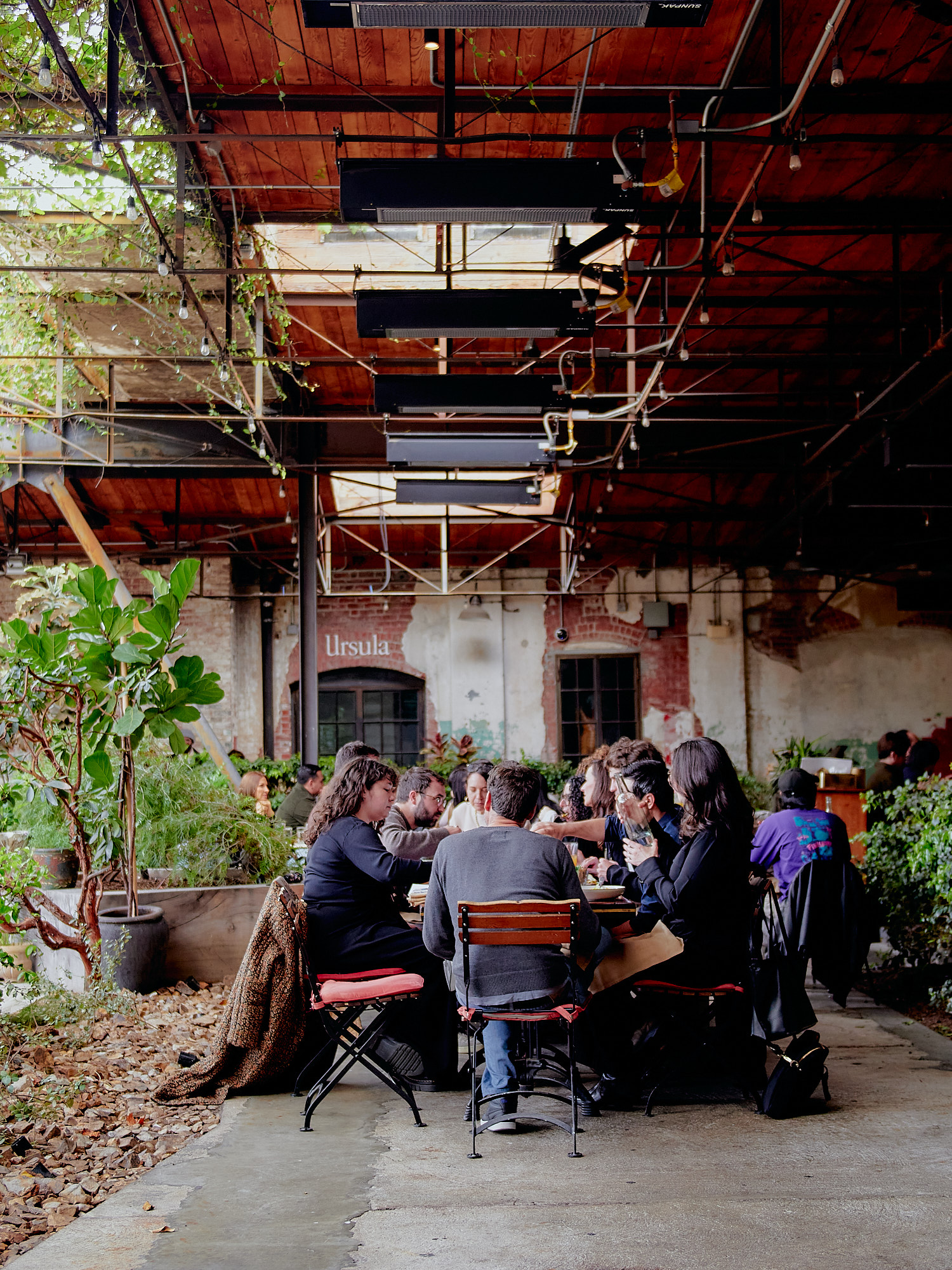
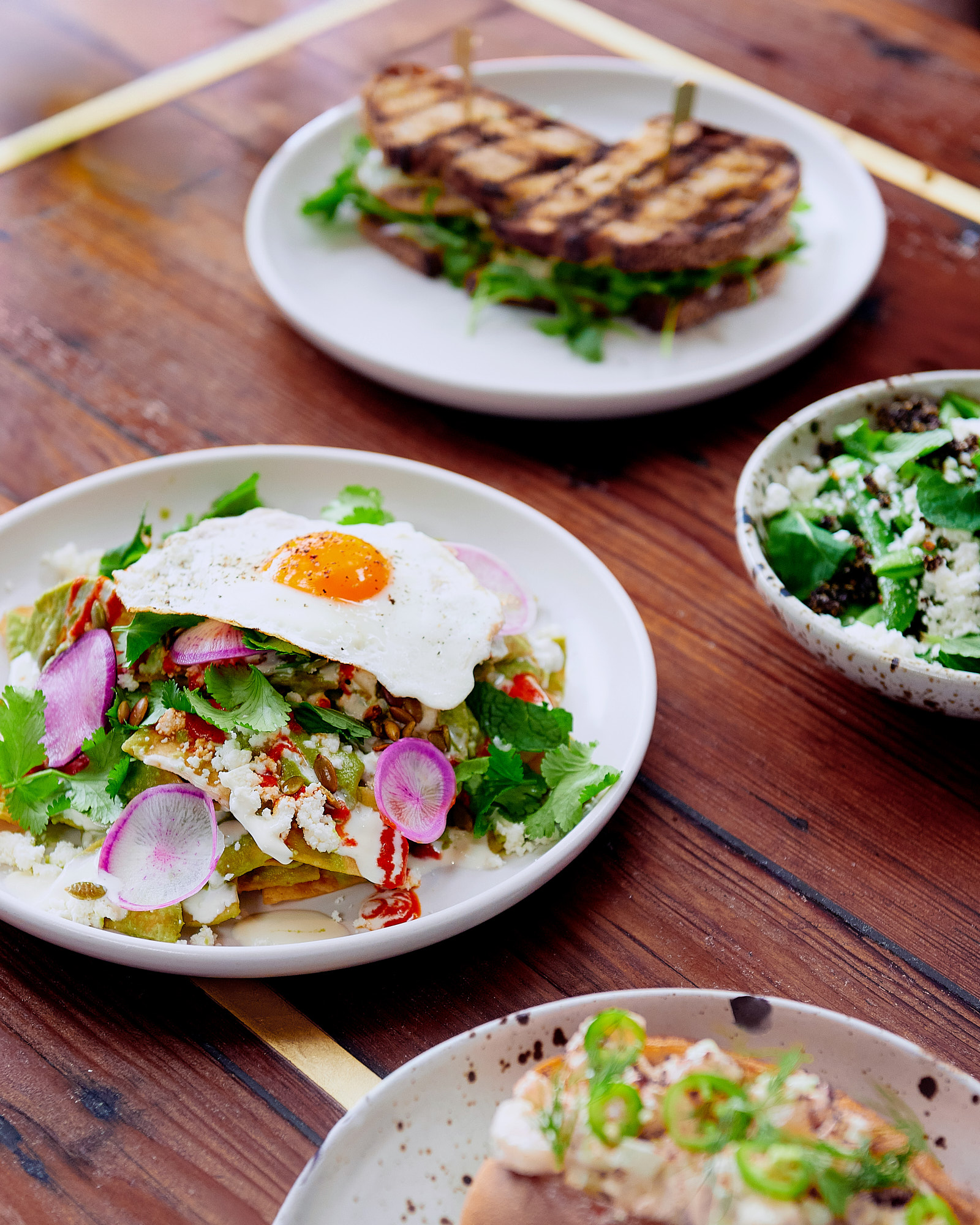
figs.vii-ix
The food that Executive Chef Kris Tominaga creates changes regularly and is very competitively priced. Our al fresco table was soon covered in colourful plates including: Louisiana shrimp roll; green salsa chilaquiles with fried egg, pepitas, and crema; blood orange, avocado, and pistachio salad; blistered snap peas, black quinoa, and sesame date butter. As well as the food, there are cocktails, mocktails, and a vast selection of wines and beers, plenty to refresh before hitting some more art…
The other gallery in the Downtown LA space is inside the former banking building, a solid neoclassical building, decorated in places with the Global Grain and Milling logo, and now toplit with a huge rooflight cutting through the main space. When we visited, paintings by British artist George Rouy were showing distorted, moving, and overlayed human figures. Titled The Bleed, Part II (Part I was presented in Hauser & Wirth’s London gallery last year) the abstracted paintings show forms seemingly between places, whether life/death, still/movement, or pleasure/pain.
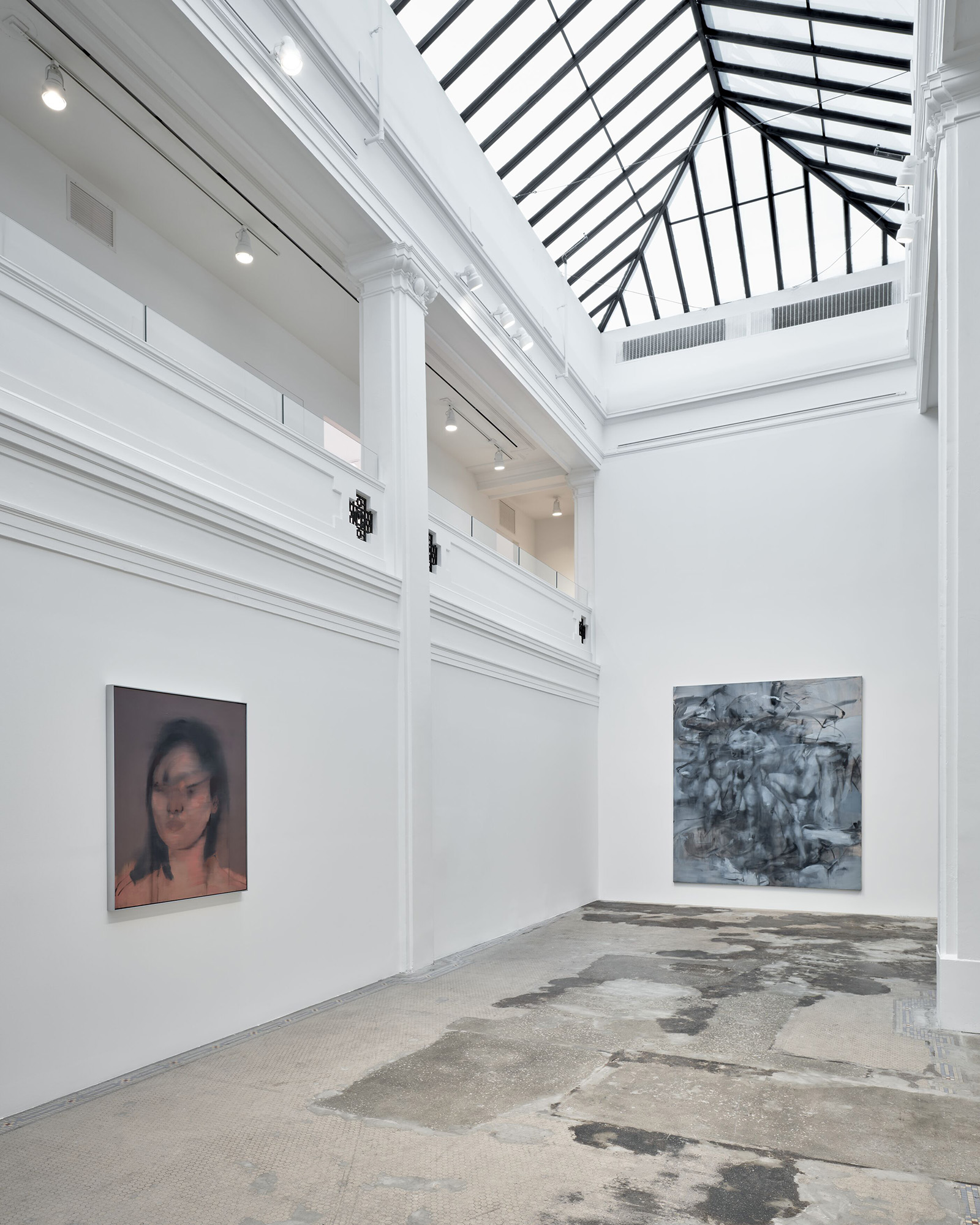
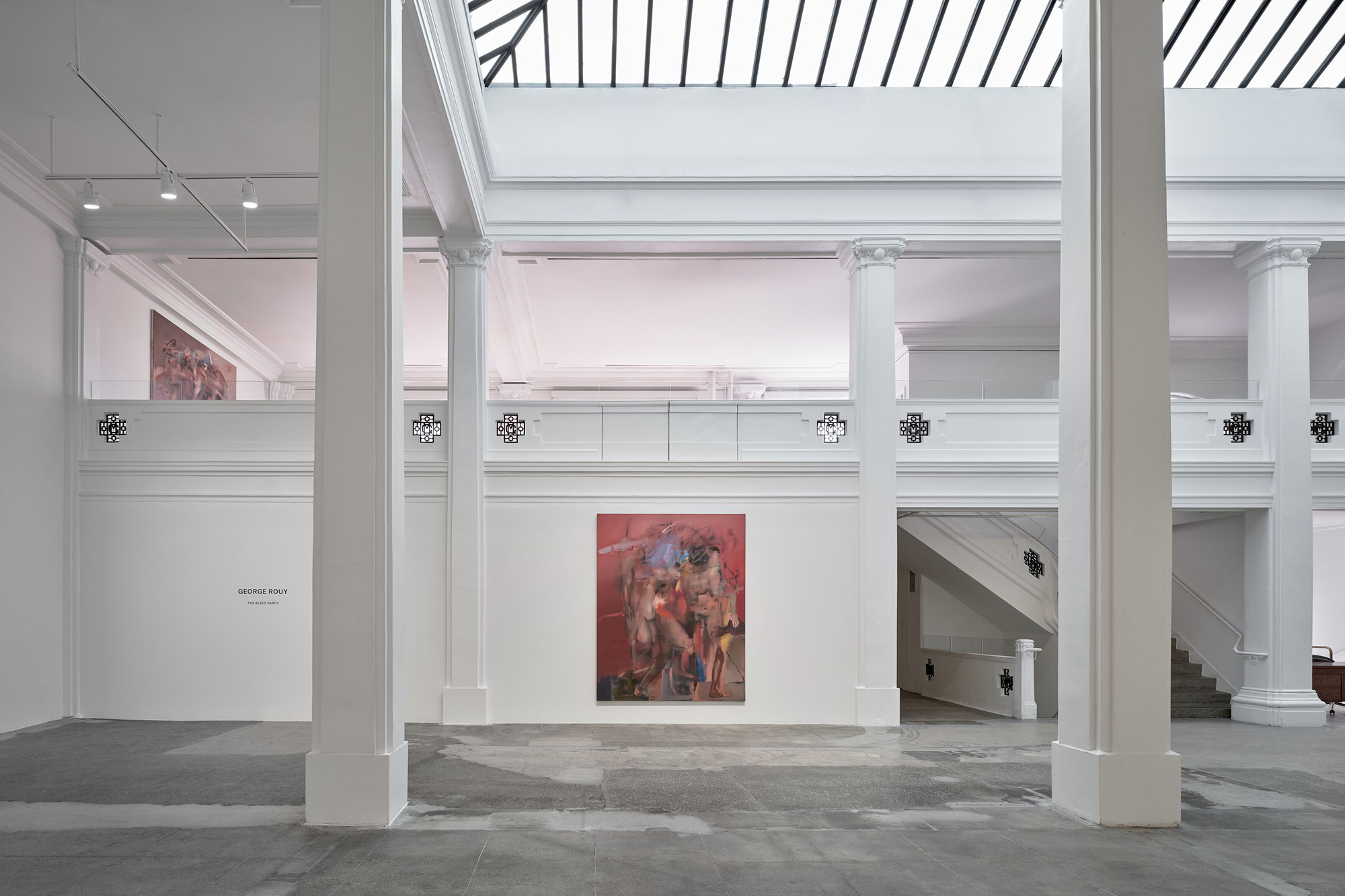
figs.x,xi
Other spaces around the reimagined industrial buildings open up for other cultural uses. The Ursula Kiosk presents and profiles the in-house magazine, Ursula. ARTBOOK @ Hauser & Wirth is a packed bookshop with a wide selection of cultural titles, including the gallery’s own imprint. Downstairs, spaces are offered up for community workshops and education through partnerships with local institutions including SCI-Arc, the Hammer Museum, LA Public Library, California Institute of the Arts, and the Garden School Foundation.
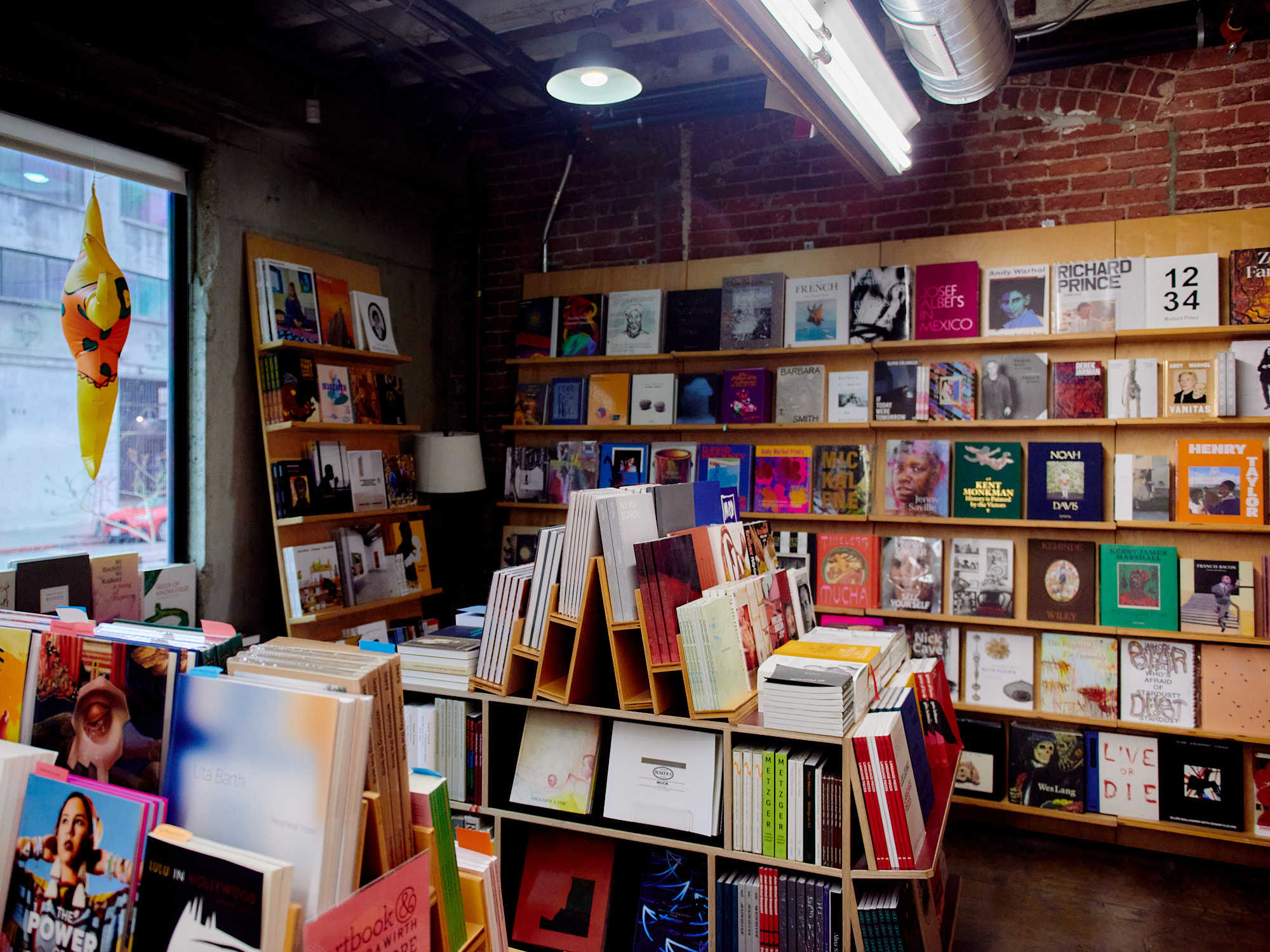
fig.xii
Few galleries seek to do much more than show and sell art, and often art gallery architecture reflects this simple transactional existence – white boxes easily inserted into any commercial space, quick to build quick to leave should the market change. Hauser & Wirth go deeper. Sure, they want to sell art, but it’s part of a wider ecosystem that adds value to the objects shown and sold, but also adds value to their existence in a place, whether that be an island or city centre, and whether they are working with nature or people. Architecture is central to it, not only as a contextual backdrop, but to create the specific conditions and approaches to everything that grows within.
Hauser & Wirth was founded in 1992 in Zurich by Iwan Wirth, Manuela Wirth and Ursula Hauser, who were joined in 2000 by Partner and President Marc Payot. A family business with a global outlook, Hauser & Wirth represents over 90 artists and estates who have been instrumental in shaping its identity and who are the inspiration for Hauser & Wirth’s diverse range of activities that engage with art, education, conservation and sustainability.
The gallery has built a reputation for its dedication to artists and support of visionary artistic projects worldwide. In addition to presenting a dynamic schedule of exhibitions, the gallery collaborates with renowned curators to present museum quality surveys and invests considerable resources in new scholarship and research. Since its earliest days, Hauser & Wirth has mounted historically significant exhibitions. The inaugural exhibition in 1992 took place in the first-floor apartment of an Art Deco villa in the heart of Zurich; it united mobiles and gouaches by Alexander Calder with sculptures and paintings by Joan Miró. Since then, the gallery has continued to forge an ambitious and academically rigorous program of historic exhibitions, providing a natural home for a number of major 20th-century artist estates and encouraging a continued and engaging discourse around their oeuvres. These include Louise Bourgeois, The Estate of Philip Guston, The Eva Hesse Estate, Allan Kaprow Estate, Mike Kelley Foundation for the Arts, The Estate of Jason Rhoades, Dieter Roth Estate and The Estate of David Smith.
www.hauserwirth.com
visit
To find out more about Hauser & Wirth Downtown Los Angeles as well as their current programme of events & exhibitions, visit their website here:
www.hauserwirth.com/locations/10069-hauser-wirth-los-angeles
For information on or reservations at Manuela, visit: www.manuela-la.com
images
figs.i,iii-v,vii-ix,xii Photographs
© Carlo Zambon.
figs.ii,x,xi
Installation view, George Rouy. The Bleed,
Part II, Hauser & Wirth Downtown Los Angeles. 18 February – 1 June 2025. © George Rouy. Courtesy the artist, Hannah Barry Gallery and Hauser & Wirth. Photo: Keith Lubow.
fig.vi
David Hammons.
Concerto in Black and Blue (2002–03). © 2025 David Hammons / ARS, New York. Courtesy the artist and Hauser & Wirth. Photo: Linda Goode Bryant.
fig.ii Sed consequat ante eget magna rhoncus ultricies laoreet sit amet odio. © Lorem Ipsum
fig.ii Sed consequat ante eget magna rhoncus ultricies laoreet sit amet odio. © Lorem Ipsum
publication date
20 August 2025
tags
Arts District, Art Farm, Bookshop, Chickens, Community, Creative Space, Downtown, Education, Gallery, Garden, Globe Grain & Milling, David Hammons, Hauser & Wirth, LA, Los Angeles, Manuela, Post-industrial, Evan Raabe, Restaurant, George Rouy, Seldorf Architects, Anabelle Selldorf, Studio MLA, Kris Tominag, Ursula, Matt Winter, Carlo Zambon
www.hauserwirth.com/locations/10069-hauser-wirth-los-angeles
For information on or reservations at Manuela, visit: www.manuela-la.com


